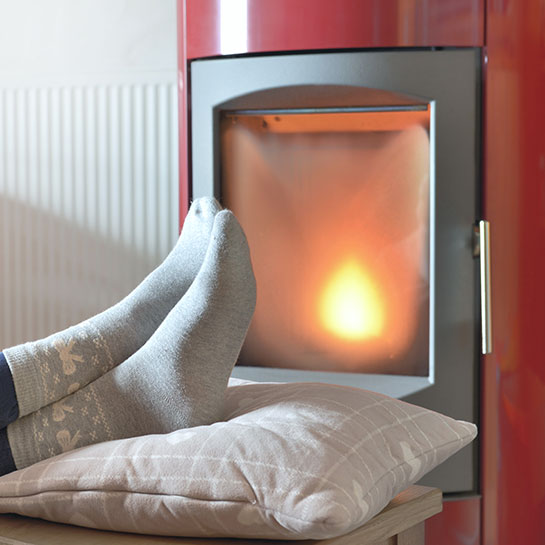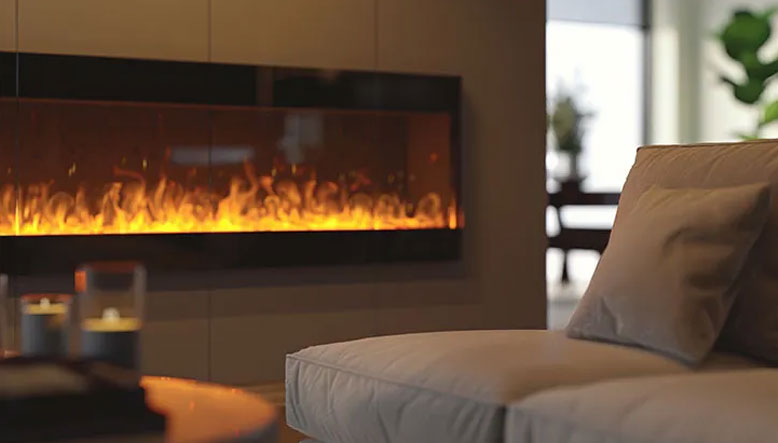The fireplace is an iconic element in the living room that brings warmth, elegance and a cozy atmosphere. Whether as a primary heating source or as a decorative detail, choosing the right type between a wood-burning and an electric fireplace can transform the space. Both types have unique features and offer advantages and disadvantages worth considering. This article aims to help you decide between the two options, based on key factors such as installation, maintenance, consumption and style.
Pros and cons of wood-burning fireplaces
Advantages of wood-burning fireplaces
- Authentic and powerful heat: Wood-burning fireplaces are especially effective for heating large spaces, generating a warm, rustic ambiance. The crackling of the flames and the natural aroma create a cozy atmosphere that is difficult to replicate with other types of heating.
- Sustainability: They use wood as a fuel source, a renewable and economical option in many areas. If the wood is obtained from responsible sources, this type of fireplace is a relatively environmentally friendly option.
- Decorative style: They fit perfectly in rustic, classic or vintage decors, and add a touch of authenticity and tradition to the living room.
- Energy independence: They are not dependent on electricity, making them an excellent option in areas with frequent power outages or where access to electricity is limited.

Disadvantages of wood-burning fireplaces
- Complex installation: They require the installation of a smoke outlet and a safety zone due to real fire handling, which may involve extra costs and time.
- Difficulty in controlling the temperature: The intensity of the heat depends on the amount of wood added to the fire, which makes it difficult to control the temperature precisely.
- Maintenance required: They generate ash and soot residues, which must be cleaned regularly. In addition, space is needed to store firewood safely.
- Space requirements: They work best in large rooms, where their powerful heating capacity can be spread over the area without problems.
Pros and cons of electric fireplaces
Advantages of electric fireplaces
- Simple installation and no construction work: Electric fireplaces do not require flues or complicated construction work; all you need is a plug to put them into operation, which makes them ideal for apartments and small spaces.
- Decorative versatility: There is a wide variety of models and modern designs that can be integrated into any environment. Some offer additional functions, such as remote control and temperature programming, making them practical and functional.
- Minimal maintenance: Unlike wood-burning fireplaces, electric fireplaces do not generate waste or smoke. This means less cleaning effort and more durability without the need for special ductwork.
- Safety: By not using real fire, there is no risk of fire or accidental burns. This makes them a safer option, especially in homes with children or pets.

Disadvantages of electric fireplaces
- Electricity dependency: Electric fireplaces do not work in case of power outages, which can be a drawback in places where power outages are frequent.
- High energy consumption: Using them as the main heating source can result in high electricity bills, especially if the model is not energy efficient.
- Limited heat: Although they are capable of heating small areas, they are not as effective as wood-burning fireplaces for heating large rooms or in very cold climates. Their use is more common as a decorative element than for heating.
Comparison of Energy Consumption and Efficiency
Electric fireplaces: In general, they are more efficient at converting electricity into heat, allowing specific temperature control. However, the cost of electricity can make prolonged use less cost-effective, especially in winter.
Wood-burning fireplaces: Although wood consumption depends on the quality and quantity used, this type of fireplace is usually more economical in the long run in areas where firewood is accessible and affordable. However, they require extra effort to manage and store the fuel.
Comparison Chart: Wood Fireplace vs. Electric Fireplace
| Appearance | Wood-burning fireplace | Electric Fireplace |
| Installation | Requires construction work and smoke venting | Only electrical connection is required |
| Heat generated | High, ideal for large spaces | Moderate, ideal for small spaces |
| Temperature control | Limited, depends on firewood | Precise and adjustable control |
| Maintenance | Regular cleaning of ashes | Minimal dusting only |
| Decorative style | Rustic, vintage | Modern, versatile |
| Security | Caution with fire and smoke | High safety, no real flame |
Practical Installation Considerations
Space and location: The choice of a wood-burning or electric fireplace will depend on the size of the room and the type of heating needed. In small spaces, an electric fireplace is ideal for its simple installation and safe design.
Style and needs: If you are looking for a traditional style and have the time for maintenance, a wood-burning fireplace will be a lovely choice. For those who prefer comfort and safety, an electric fireplace is the most practical option.
Choosing between a wood-burning or electric fireplace depends largely on your lifestyle, the size of your space and how you will use it. Wood-burning fireplaces are perfect for those looking for powerful heat and traditional charm, while electric fireplaces are a modern, decorative and low-maintenance option. Before deciding, consider your personal preferences and the space available in your living room so that the choice meets both your practical needs and your style.
Which fireplace is easier to install and maintain?
Electric fireplaces are easier to install and require less maintenance than wood-burning fireplaces.
Which one is more suitable for a small living room?
An electric fireplace is ideal for smaller living rooms, as it takes up less space and does not require flues.
Can electric fireplaces be used as the main source of heat?
In temperate climates, they can serve as the main source of heat in small spaces, but are usually not sufficient for cold climates or large areas.
Which is safer in homes with children or pets?
Electric fireplaces are safer because they do not involve real fire, which minimizes the risk of burns or accidents.
Are there hybrid or customized alternatives to combine the best of both?
Some modern fireplaces combine electric and gas functions, and there are also models with advanced visual effects that mimic wood fires without the inconvenience of smoke and maintenance.






